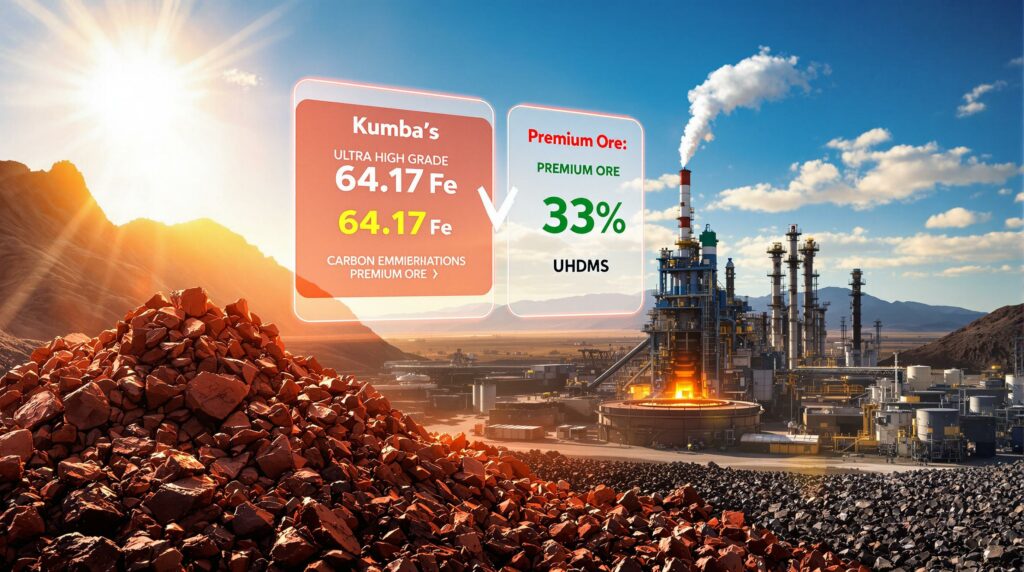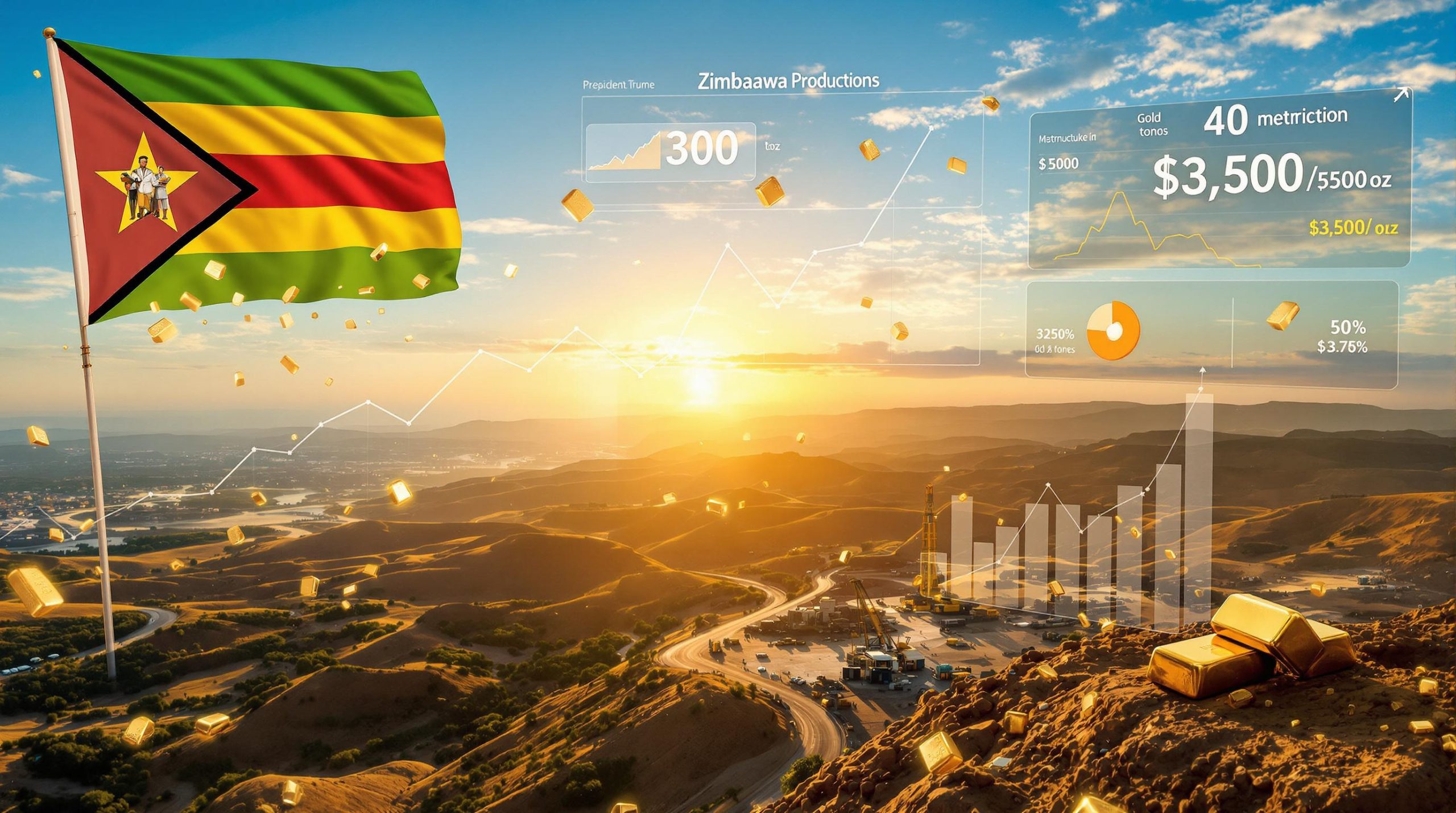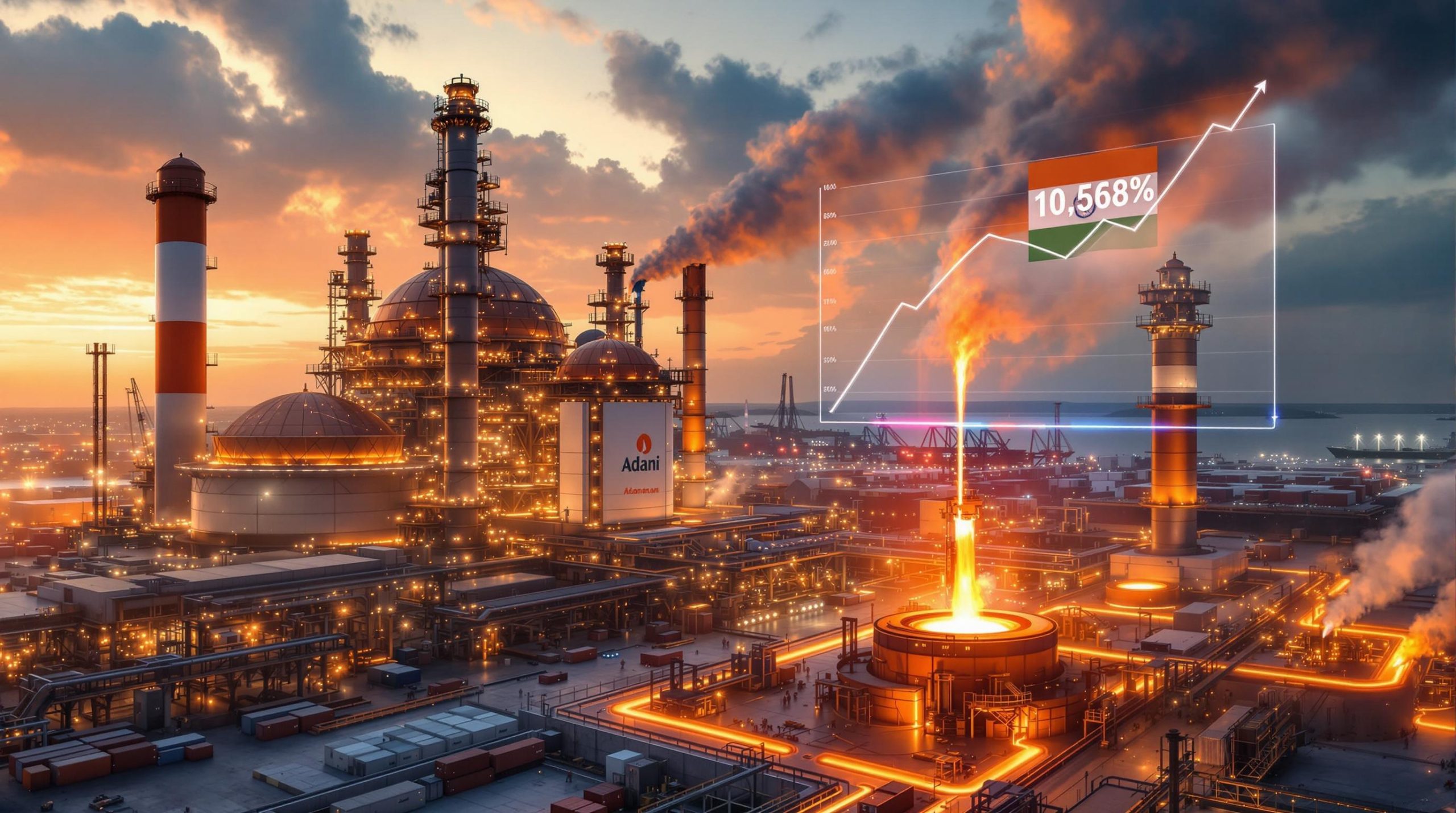What Makes Kumba Iron Ore's Products Environmentally Advantageous?
South Africa's Kumba Iron Ore and reducing carbon emissions in steelmaking stands out in the global mining industry through its production of premium-quality iron ore that offers significant environmental benefits. Operating in the Northern Cape region, Kumba has established itself as a leader in providing high-grade iron ore that actively contributes to reducing carbon emissions in steelmaking processes worldwide.
Superior Iron Content Above Industry Standards
Kumba's iron ore contains remarkably high ferrous content, measuring 64.1% for the first half of 2025. This substantially exceeds the industry benchmark Platts 62% Fe index, creating an immediate environmental advantage. This quality differential is becoming increasingly significant as the broader industry faces declining ore grades, with some major producers' output dropping to as low as 61% Fe content.
"The superior iron content of Kumba's ore directly translates to lower carbon emissions in steel production. As a rule of thumb, each 1% increase in Fe content lowers CO₂ emissions by 2.5%." – Mining Weekly, August 11, 2025
This quality advantage is particularly valuable as steel manufacturers worldwide seek practical pathways to reduce their carbon footprint without requiring massive capital investments in new production facilities.
Exceptional Lump-to-Fine Ratio
Another distinctive environmental advantage comes from Kumba's impressive 67:33 lump-to-fine ratio in its production output. This proportion significantly outperforms what other major iron ore producers typically achieve, where fine ore usually dominates the production mix.
The environmental significance of this ratio cannot be overstated:
- Lump ore can be fed directly into blast furnaces without additional processing
- Fine ore requires sintering (an energy-intensive agglomeration process)
- By providing more lump ore, Kumba eliminates energy-intensive processing steps
- This elimination of sintering reduces CO₂ emissions by approximately 10%
Environmental Impact of Higher-Grade Ore
The combined environmental benefits of Kumba's premium-grade iron ore create a compelling value proposition for steelmakers pursuing decarbonisation in mining:
| Quality Factor | Environmental Benefit | CO₂ Reduction |
|---|---|---|
| Higher Fe content (64.1% vs. 62%) | Less energy required for processing | ~5% reduction |
| Superior lump-to-fine ratio (67:33) | Elimination of sintering process | ~10% reduction |
| Combined effect | Significantly lower carbon footprint | ~15% reduction |
These quality differentials position Kumba's products as an immediate solution for steelmakers looking to reduce their environmental impact without massive capital expenditure on new technologies or production methods.
How Does High-Grade Iron Ore Support Decarbonization in Steelmaking?
The steel industry faces enormous pressure to reduce its carbon footprint, accounting for approximately 7-9% of global carbon emissions. Kumba's high-grade iron ore plays a vital role in this transition by enabling both immediate emission reductions in existing facilities and supporting newer, lower-carbon production methods.
Carbon Reduction in Traditional Blast Furnaces
Traditional blast furnace steelmaking remains the dominant global production method, representing approximately 70% of worldwide steel output. Within this established technology, Kumba's premium products deliver substantial environmental benefits:
- Higher energy efficiency: The higher iron content requires less energy to process, reducing coal consumption
- Reduced flux consumption: Higher-grade ore requires fewer additives to remove impurities
- Improved furnace productivity: Better quality input materials allow for increased production rates with the same energy input
- Extended equipment life: Less impurities result in reduced wear on production equipment
These advantages make Kumba's ore particularly valuable for immediate decarbonization efforts in existing facilities, where replacement with alternative technologies would require billions in capital investment.
Supporting Direct Reduction Steelmaking
Beyond traditional methods, Kumba's high-grade ore is exceptionally well-suited for direct reduction (DR) in direct reduced iron (DRI) production. This process uses natural gas instead of coal as a reducing agent, offering a substantially lower carbon footprint.
The direct reduction process works by:
- Removing oxygen from iron ore using natural gas (primarily methane)
- Creating solid metallic iron without melting the ore
- Processing the resulting direct reduced iron in electric arc furnaces
- Producing steel with approximately 50% lower carbon emissions than traditional methods
Kumba's high iron content and low impurity levels make its products ideal inputs for this process, which requires ore with Fe content typically above 67%. Through South African beneficiation processes, Kumba can provide products that meet these stringent requirements.
Long-Term Industry Outlook
The transition to lower-carbon steelmaking will necessarily be gradual due to the massive existing infrastructure investment:
- More than 70% of global blast furnace capacity is less than 20 years old
- Most existing blast furnaces have expected operational lifespans of at least another 20 years
- Combined with DRI-steelmaking, these methods will continue to account for over 60% of global production
- Complete transition to hydrogen-based or electrified steelmaking remains decades away for most producers
This reality creates sustained demand for high-quality iron ore that can reduce emissions within existing infrastructure, positioning Kumba's products as a critical bridge technology in the steel industry's decarbonization journey.
What Premium Does Kumba Earn for Its Environmental Benefits?
The environmental advantages of Kumba's iron ore translate directly into financial benefits through premium pricing in the global market. These premiums reflect both the technical superiority of the product and the growing importance of reduced-carbon inputs for steelmakers worldwide.
Market Recognition Through Pricing
Kumba has established a consistent track record of commanding significant price premiums:
- In H1 2025, Kumba achieved an average realized FOB export price of $91 per wet metric tonne
- This price represented an 8% premium above the industry benchmark price
- The company earned an $11/t premium specifically for its Fe content and lump quality
- After accounting for marketing and timing effects, Kumba realized a net product premium of $7/t
These premiums highlight the market's willingness to pay more for products that deliver both operational efficiency and environmental benefits. As global pressure for carbon reduction intensifies, this premium is likely to increase rather than decrease.
"The premium Kumba commands for its high-quality iron ore reflects both its operational advantages and its role in helping steelmakers meet increasingly stringent environmental standards." – Mining Weekly, August 11, 2025
The sustainability of these premiums is reinforced by several factors:
- Declining quality from major competing ore bodies in Australia and Brazil
- Increasing carbon taxes and regulations in major steel-producing regions
- Growing customer preference for steel produced with lower environmental impact
- Limited new discoveries of high-grade iron ore deposits globally
Future Premium Growth Through Technology
Kumba is implementing ultrahigh dense medium separation (UHDMS) technology to further enhance its premium product offerings and strengthen its market position:
- UHDMS will nearly triple the volume of premium-grade product as a proportion of total production at Sishen
- Premium-grade volumes will increase from less than 20% to more than 50% of output
- This technological advancement is expected to generate an additional marketing premium of $2-3 per dry metric tonne
This strategic investment in beneficiation technology demonstrates Kumba's commitment to maximizing the value of its resource base while simultaneously improving its environmental contribution through green iron sustainability.
The financial impact of this technology extends beyond direct price premiums:
| Benefit Category | Impact |
|---|---|
| Higher product premiums | Additional $2-3/dmt |
| Extended mine life | Sishen operations extended to 2040 |
| Lower mining costs | $2-3/dmt reduction through processing in-situ C-grade material |
| Reduced capital requirements | Elimination of need for significant mining equipment expansion |
These combined benefits create a compelling business case for Kumba's continued investment in technology that enhances both product quality and environmental performance.
How Is Kumba Using Technology to Enhance Sustainability?
Technological innovation stands at the center of Kumba's sustainability strategy. Through advanced beneficiation methods, the company is simultaneously improving resource utilization, extending mine life, and enhancing product quality—all while reducing environmental impact.
Ultrahigh Dense Medium Separation (UHDMS) Implementation
The UHDMS technology being deployed at Kumba's operations represents a step-change in mineral processing capability, delivering multiple sustainability benefits:
- Improved resource utilization: Lowers the cutoff grade from 48% to 40%, allowing previously uneconomic material to be processed
- Waste reduction: Reduces the life-of-mine stripping ratio from 4.2 to 3.6, minimizing the amount of waste rock that must be removed
- Extended operational life: Extends Sishen's life-of-mine to 2040, improving long-term resource management and community stability
- Cost efficiency: Enables processing of in-situ C-grade material, reducing mining costs by $2-3/dmt
- Capital efficiency: Eliminates the need for significant mining equipment expansion, reducing both financial investment and associated embedded carbon
The UHDMS process works by creating a suspension of finely ground ferrosilicon in water at a specific density. When iron ore is introduced to this medium, the higher-density iron-rich particles sink while lower-density waste material floats, allowing for highly efficient separation based on density differentials as small as 0.1 g/cm³.
This precision allows Kumba to:
- Process lower-grade material that would previously have been considered waste
- Produce higher-grade products from the same resource base
- Reduce the amount of energy and water required per ton of final product
- Extend the productive life of existing mining operations
From an environmental perspective, UHDMS delivers several important benefits:
- Reduced land disturbance: Lower stripping ratio means less area needs to be mined
- Improved water efficiency: More efficient separation process reduces water consumption per ton
- Energy savings: Less material handling and processing of waste rock reduces overall energy use
- Higher-quality products: Enhanced Fe content leads to lower emissions in steelmaking
Strategic Expansion Potential
While currently implemented at Sishen, UHDMS technology has broader application potential across Kumba's operations:
- Kolomela expansion: Similar UHDMS conversion could be implemented at Kumba's Kolomela operation
- Brownfield potential: Technology could unlock value from previously mined areas with remaining lower-grade material
- Exploration focus: Changes exploration economics by making lower-grade deposits potentially viable
The technology also positions Kumba to potentially process historical waste dumps, further extending resource life while remediating legacy mining impacts—a true circular economy approach to resource management.
What Socioeconomic Impact Does Kumba Have in South Africa?
Beyond its environmental contributions, South Africa's Kumba Iron Ore and reducing carbon emissions in steelmaking serves as a critical economic engine for South Africa's Northern Cape region. The company's operations create substantial direct and indirect benefits through employment, procurement, and community development initiatives.
Local Employment and Economic Contribution
Kumba's commitment to local employment and economic development is reflected in several key metrics:
- Local hiring focus: 80% of workforce comes from local mine communities
- Gender diversity: 30% of workforce consists of women, well above mining industry averages
- Economic impact: R3.5 billion paid in salaries and benefits in H1 2025
- Supply chain development: R8.2 billion spent with qualifying BBBEE suppliers in H1 2025
- Community business support: R1.4 billion directed to host community-owned businesses
This focus on local economic development creates a multiplier effect throughout the region, with each direct mining job supporting approximately 3-5 additional jobs in the broader economy through supplier and consumer spending.
Community Development Initiatives
Kumba's community investment programs deliver wide-ranging benefits beyond direct employment:
- Entrepreneurship development: 670 jobs facilitated outside the mining industry in H1 2025
- Long-term impact: Over 42,000 jobs created outside mine operations since 2018
- Strategic social investment: R135 million invested in social programs
- Healthcare innovation: Introduction of Collect & Go Smartlockers to improve access to chronic medication
- Educational support: R11 million community bursary program benefiting 78 young people
- School development: Support for 19 schools, benefiting 10,400 learners and 330 teachers
- Academic excellence: R1 million contribution to top 20 matriculants in the Northern Cape
These initiatives are strategically designed to build sustainable community capacity that will outlast the mines themselves, addressing one of the most persistent challenges in mining-dependent communities—post-mining economic transition.
The company's approach focuses on five key development areas:
- Education and skills development: Building human capital for diverse economic opportunities
- Healthcare improvement: Ensuring community wellbeing and productivity
- Enterprise development: Creating sustainable businesses beyond mining
- Infrastructure development: Improving quality of life and economic potential
- Agricultural support: Developing alternative livelihoods with long-term viability
Total Value Creation
Kumba's operations generate substantial shared value across multiple stakeholder groups:
- R25.9 billion in total shared value created in H1 2025
- R5.3 billion in dividends to shareholders
- R1.9 billion to empowerment partners
- R7.1 billion to government through taxes and royalties
- R11.6 billion to employees, communities and suppliers
This balanced distribution of economic benefits demonstrates how mining, when done responsibly, can serve as a catalyst for broad-based development while simultaneously delivering shareholder returns and environmental improvements.
What Challenges and Solutions Exist in Kumba's Logistics Infrastructure?
Despite its production excellence, Kumba faces significant challenges in getting its products to global markets due to South Africa's logistics infrastructure constraints. Addressing these challenges is critical not only for Kumba's business performance but also for maximizing the environmental benefits of its premium products.
Current Rail and Port Performance
Recent developments show encouraging signs of progress in South Africa's mineral export infrastructure:
- Rail performance improved to 83% of contracted volumes, up from historic lows
- Improved equipment availability at the Port of Saldanha Bay has enhanced loading rates
- These improvements have enabled a 3% increase in sales volumes
However, significant challenges remain in consistently delivering Kumba's full production potential to global markets, where its environmental benefits can be realized.
"The infrastructure limitations represent a bottleneck not just for Kumba's financial performance, but for the global steel industry's decarbonisation efforts." – Mining Weekly, August 11, 2025
Collaborative Infrastructure Solutions
Recognizing that infrastructure challenges require multi-stakeholder solutions, Kumba is actively collaborating with partners across the public and private sectors:
- Technical support: Providing ongoing technical expertise to Transnet, South Africa's state-owned freight rail company
- Industry collaboration: Working through the Ore User's Forum (OUF) to align stakeholder interests
- Formal cooperation: Finalizing the Mutual Cooperation Agreement (MCA) between Transnet and OUF
- Restoration program: Participating in the comprehensive Ore Corridor Restoration program
These collaborative efforts focus on both immediate operational improvements and longer-term structural solutions to ensure sustainable infrastructure performance.
The approach includes several parallel workstreams:
- Technical optimization: Improving maintenance practices and operational efficiency
- Resource allocation: Ensuring critical equipment and personnel are deployed effectively
- Process improvement: Streamlining administrative and operational procedures
- Capital planning: Identifying and prioritizing critical infrastructure investments
Future Infrastructure Development
Long-term solutions to South Africa's logistics challenges require substantial investment and potentially new ownership and management models:
- Technical assessment: Independent Technical Assessment completed to identify necessary improvements
- Capital requirements: Significant investment needed to restore the system to design capacity
- Private sector participation: Exploring private-sector involvement in managing and maintaining the ore export channel
- Government engagement: Active participation in the government's Private Sector Partnership process
- Formal submissions: Response submitted to request for information from the Department of Transport
These efforts reflect a recognition that sustainable logistics solutions will require innovative public-private partnerships that leverage the strengths of both sectors while ensuring national infrastructure serves broad economic development goals.
The potential models under consideration include:
- Concession arrangements: Private operation of specific rail lines or port terminals
- Joint investment frameworks: Shared public-private financing of infrastructure improvements
- Dedicated capacity arrangements: Guaranteed access to specific infrastructure capacity
- Performance-based management contracts: Private sector management with performance incentives
Successfully resolving these logistics challenges would not only improve Kumba's business performance but also enhance South Africa's competitiveness as a supplier of premium, environmentally advantageous iron ore to global markets.
How Does Kumba's Business Performance Reflect Its Sustainability Strategy?
Kumba's financial and operational results demonstrate that environmental and social sustainability can go hand-in-hand with strong business performance. The company's strategy of focusing on premium products and operational excellence delivers results across multiple dimensions of mining innovation trends.
Financial Results
Despite global economic uncertainty, Kumba continues to deliver robust financial performance:
- Strong profitability: EBITDA of R16 billion in H1 2025
Looking to Identify the Next Major Mineral Discovery?
Enhance your investment strategy with real-time alerts on significant ASX mineral discoveries, powered by Discovery Alert's proprietary Discovery IQ model that transforms complex mineral data into actionable insights. Explore why historic discoveries can generate substantial returns by visiting Discovery Alert's dedicated discoveries page and begin your 30-day free trial today.




